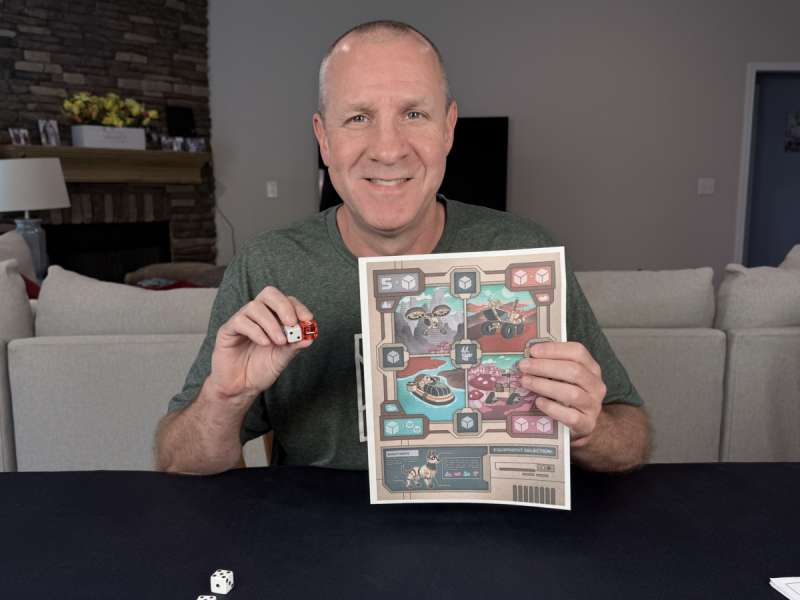
REVIEW – We love to play tabletop games, and one genre that has been very popular of late at our house is roll-and-write games like Three Sisters, Welcome To, and Next Station. For those not familiar, a roll-and-write is a game where a set of communal dice are rolled in the center of the table, and players use the values of the dice to perform some action, which is recorded on their personal score sheet. The original roll-and-write was Yahztee, created way back in 1956, but in the last eight years or so this genre has exploded. There are now over 1200 games with this mechanism listed on Board Game Geek. In this review, I’m testing a new roll-and-write game, Starfront Scouting Academy, from Shiny Pigeon Games.
︎ Jump to summary (pros/cons)
Price: $5 to $100
Where to buy: Kickstarter
What is it?
Starfront Scouting Academy is a roll-and-write area control game coming to Kickstarter in the summer of 2025 where “1-6 players are planetary scouting students advancing their cosmic exploration skills.” It’s also a print-and-play game, which means that backers will acquire digital copies of the rules and the gaming sheets that they can print out themselves.
What’s included?
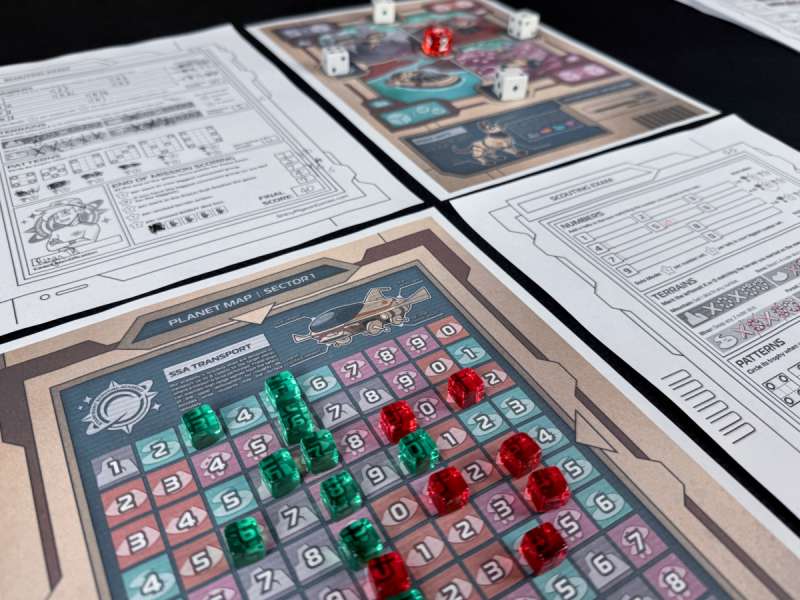
- Rulebook
- Equipment Selection, Planet Map, and Scouting Exam sheets
The sheets are available in Letter and A4 sizes, both in full color and grayscale.
Theme
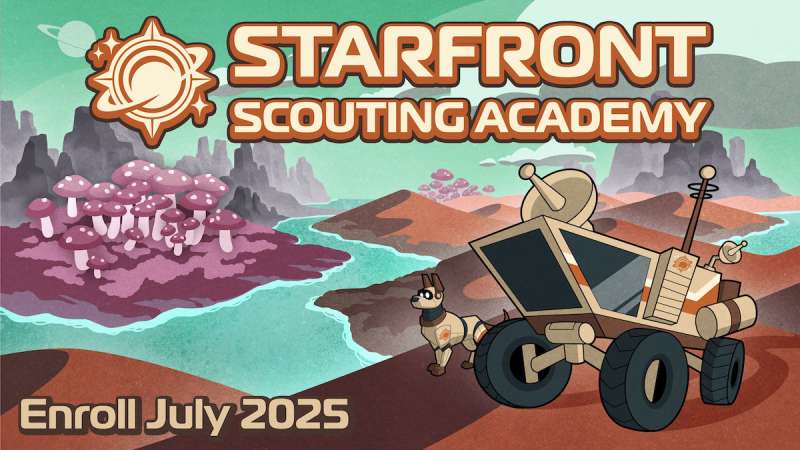
The theme of the game is that the players are cadets who have been studying at the Starfront Scouting Academy. For the final exam, they have been brought to an uninhabited planet and tasked with exploring and mapping one of its sectors using a variety of reconnaissance vehicles. The theme is very light, and gameplay quickly becomes less about exploring and more about adding dice numbers together and controlling parts of the game board.
Setup
As this is a print-and-play game, players will have to print out the equipment selection sheet, one of the four planet sector maps, and one scouting exam sheet per player. Players will also need to supply five six-sided dice, colored markers (or pencils or crayons) to mark the planet maps, and pens to record their scores on the exam sheet. The sheets can be laminated and reused with dry-erase markers. We happened to have some small game cubes handy, so we placed them on the planet maps instead of writing on them, and that worked really well for us. We chose to print grayscale exam sheets for each game.
To begin play, give one character sheet to each player. Select one of the planet maps—there are minor variations between them—and place it in the middle of the table along with the equipment sheet. Roll the five dice and place them on the five boxes on the equipment sheet.
Starfront is now ready to play!
Game Play
The idea of the game is that players will take turns using the vehicles on the equipment sheet to explore one of the terrains on the planet sector map. To do this, players will take three steps.
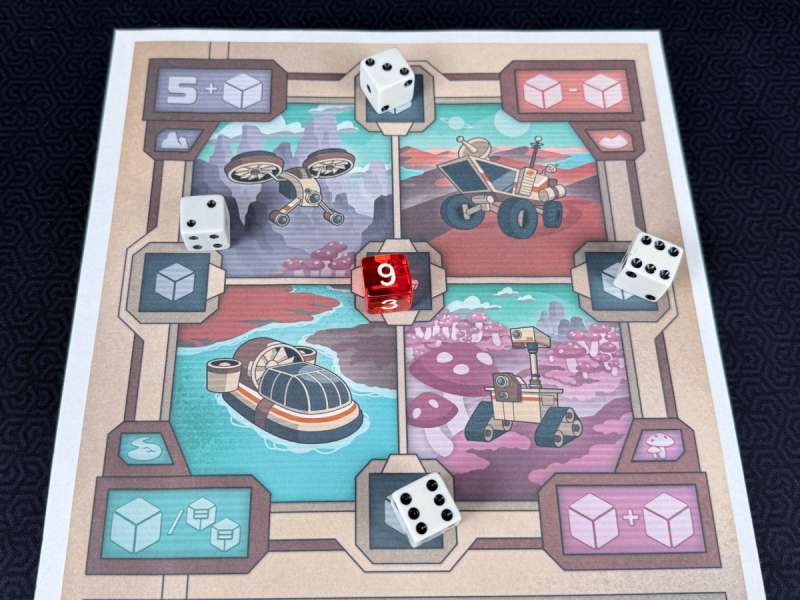
The first step is to select a number and a terrain by using the dice associated with a vehicle. Each type of terrain has slightly different rules for using the dice; the dune terrain, for example, requires a player to subtract one die from another. There are anywhere from one to three possible numbers for each terrain type, so players often spend a minute or three calculating their possible options.
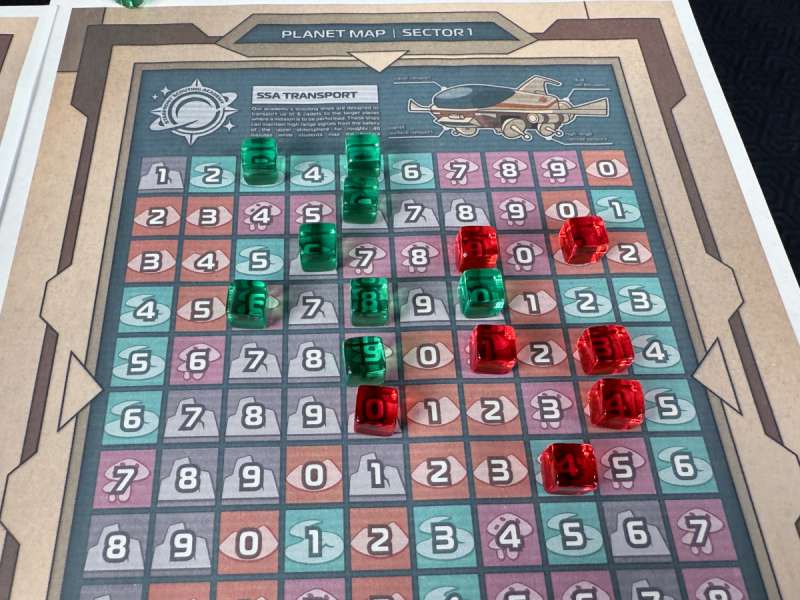
The second step is to mark one of the squares on the planet map that corresponds to the number and terrain chosen in step one. If the player selected dune and the result of subtracting two dice is a 3, then the player can mark one of the “3 of dunes” on the planet map with his marker. The player now controls that section. The player re-rolls whichever dice that he used so that the next player has fresh options.
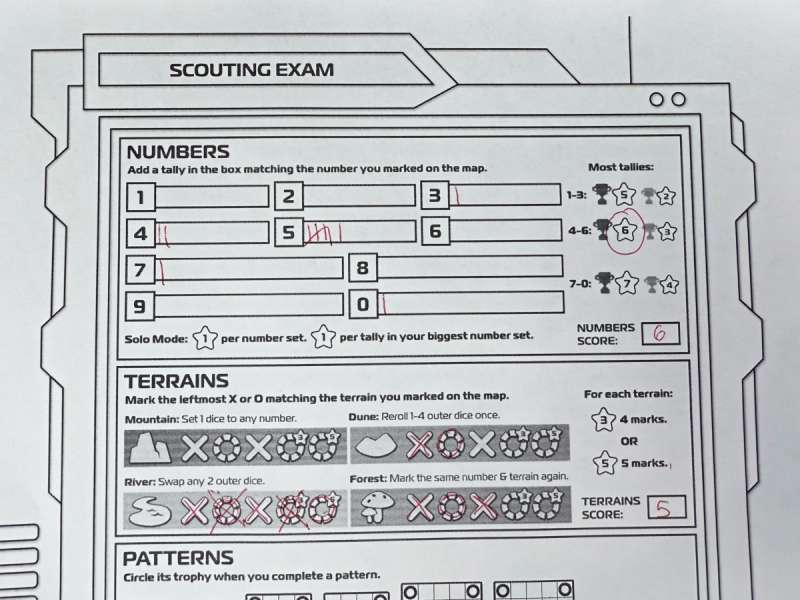
The third step is to mark what was done on the player’s exam sheet. If he selected the number 3, he puts a tally beside the 3. If he selected a dune, he puts a tally beside the dune. If he completed one of the patterns defined on the exam sheet, he marks that as complete. There are other things to keep track of as well.
There is actually a step that can happen before the first step. Each time a player marks a certain number of terrains, he gains a special ability called a terrain action that can be used in future turns to manipulate the dice and thus get a desired number. This feature of the game “breaks the rules” in order to help players get the squares on the map that they need.
End Game
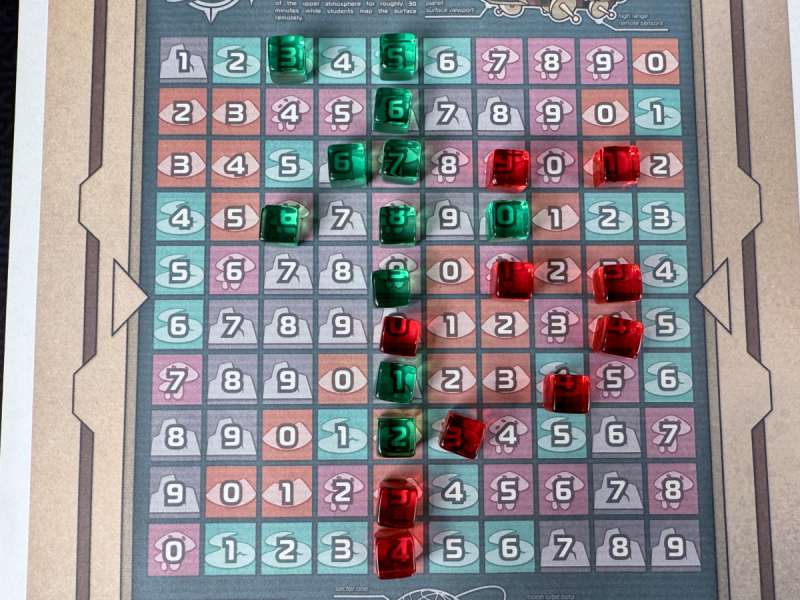
The exam (and the game) finishes when all of the squares in one straight line on the planet map (from top to bottom or from left to right) or in one diagonal line (from corner to corner) have been marked. At this point the end game condition has been reached, and the game is over once everyone has had an equal number of turns.
Points are scored on the game sheet, and there are three primary ways of scoring:
- Completing the various scouting patterns defined on the exam sheet.
- Controlling the greatest number of continuous squares on the planet (similar to longest road in Catan or longest train in Ticket to Ride).
- Controlling squares in the lines that triggered the end game condition.
There are also points for selecting the most numbers, controlling certain numbers of terrains, and not using special abilities. The player who did the best on the final exam is the one with the most points.
Game Quality
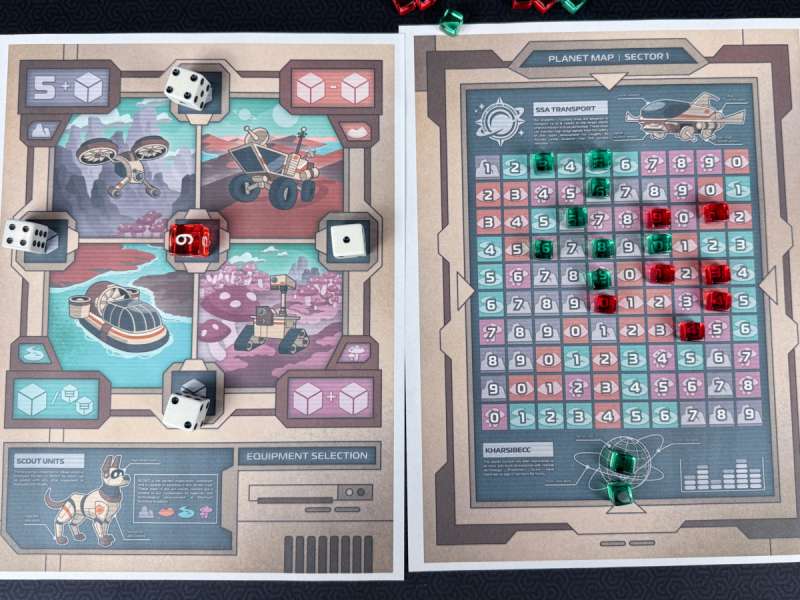
The digital downloads come in both full color and in grayscale. I suspect that many folks will want to print the equipment sheet and each of the sector maps once in color but the exam sheets in grayscale to cut costs. The artwork on these pages is simple but more than sufficient, and the scoring options are clearly laid out on the exam sheet.
I reviewed the game about five weeks before the planned start of the Kickstarter campaign. At this point in time the rules were very rough. After my first read through the game, I did not understand how to play. I had to watch the play through video created by Shiny Pigeon Games while re-reading the rules to understand how to play. As these rules are digital, I would expect this problem to be resolved by the time the Kickstarter campaign begins.
Questions
I sent a few questions to Shiny Pigeon, and the designer of the game, Chris Backe, graciously responded.
What was the inspiration for this game?
“So the original title was ‘Stake Your Claim’, and the theme was about exploring some land to, well, stake your claim. I was playing with a dice rondel and decided to pair it up with a 10×10 grid.”
Why do a print-and-write instead of a traditional boxed game with pads of game sheets?
“When I started No Box Games (now merged with Shiny Pigeon to form Shiny Pigeon Printables), I wanted to get my games out there for the world with as few ‘middlemen’ as possible. I saw Voyages from Postmark Games do so well from selling a PDF, which looked to do just that. It’s a whole lot simpler, but more importantly, it was an opportunity to create something new.”
Do buyers have an option to purchase pads of game sheets instead of printing it themselves? Are there any websites, maybe like a Shutterfly, where players could go and order them for themselves?
“This is definitely a possibility! Stay tuned to the Shiny Pigeon website.”
Are there any expansions planned that you can share? For example, will there be a version where each character has a special ability?
“As of right now, no… but there could be!”
Final thoughts
Shiny Pigeon has described this game as a roll-and-write game and as an area control game, and that’s exactly what it is. There are several things I like about Starfront Scouting Academy’s use of these mechanics:
- There are multiple mechanisms for using the dice to select a number and a terrain, thus giving players more options for getting what they want.
- The dice that were used by each player are re-rolled, thus giving new numbers for the next player.
- There are multiple ways to score, allowing for various strategies.
- The area control game is communal, forcing players to compete for a limited number of spaces on the maps.
- There are ways to “break the rules,” enabling players to have a better chance of marking a critical spot on the map.
This is the first print-and-play game that I’ve owned, and I appreciate the option to print only as many sheets of paper as I want. I’m glad that Shiny Pigeons included both color and grayscale options. People with an inkjet might not want to print out the full color version each time they play.
As our gaming groups played, we found a few hints that might be worth considering:
- Watch the river dice. Any time there are doubles, take them and get two rivers. An extra square is always good.
- The special ability for mountains is by far the best terrain action. When in doubt, start the game by getting mountains and set this terrain action up for later turns.
- The forests are the next best special ability, as it gives you two spots on one turn. When you can’t get a mountain, get a forest and set up this terrain action for later turns.
- Keep an eye on other players squares. When you see that they are close to getting one of the larger patterns, consider spending a turn blocking them. If you do this, be prepared for some frustration to come your way from your opponent, as the larger patterns take a while to setup.
Like all games, Starfront Scouting Academy does have a few areas where improvements could be made:
- The game encourages “analysis paralysis.” With all the dice possibilities and terrain actions that are available, players are encouraged to calculate every possible combination and check where they can mark on the planet map. The more this happens, the more the game slows down and the less it feels like a roll-and-write. (Roll-and-write games tend to be light and fast.) One “house rule” that could mitigate this problem is to allow every player to have their own equipment sheet and their own dice. This allows players to walk through these combinations while the other players are taking their turns.
- This game has no player interaction (think “I will trade you wood for wheat” in Catan), so there’s nothing to do when it’s not my turn. As some of the dice are re-rolled each turn, there’s really no way for me to plan strategically. As the game is turn-based instead of simultaneous, more players definitely cause more waiting; this is one of those games that tempt players to look at their phones when it’s not their turn. Starfront Scouting Academy plays best with two players, which is fine with me, because I almost always play roll-and-writes with my wife. One “house rule” that could mitigate the waiting problem is to allow all players to go simultaneously (like you do in My City). All players use the same dice at the same time to select their number and terrain, and then they select a square on the player map in turn order. All five dice are then rerolled.
- There is one flaw in the game design. The best way to win the game is to simply put all your pieces in a straight line from top to bottom and end the game as soon as possible. That’s what one of the Shiney Pigeon players did in their playthrough and what one of our play testers did as well. This works because each of these cubes are scored twice. This strategy is within the rules, but it totally ignores the theme and purpose of the game, which is to explore this sector of the planet. I understand why Shiney Pigeon wants players score points for the longest contiguous section and for being part of the end game line, but enabling this strategy to be viable causes the game to be not very fun. One “house rule” that could mitigate this problem is to double the points that are each scored for each pattern.
- The size of the board for any print-and-play is determined by the size of one’s printer, which for me means 8.5 x 11 inches. That’s a very small board, and with more than two people it becomes challenging for people without great vision to see it clearly. The board is perfect with two people, tolerable with four, but too small for six. We put the planet map on a lazy Susan in the middle of our gaming table when we played with four, and that helped.
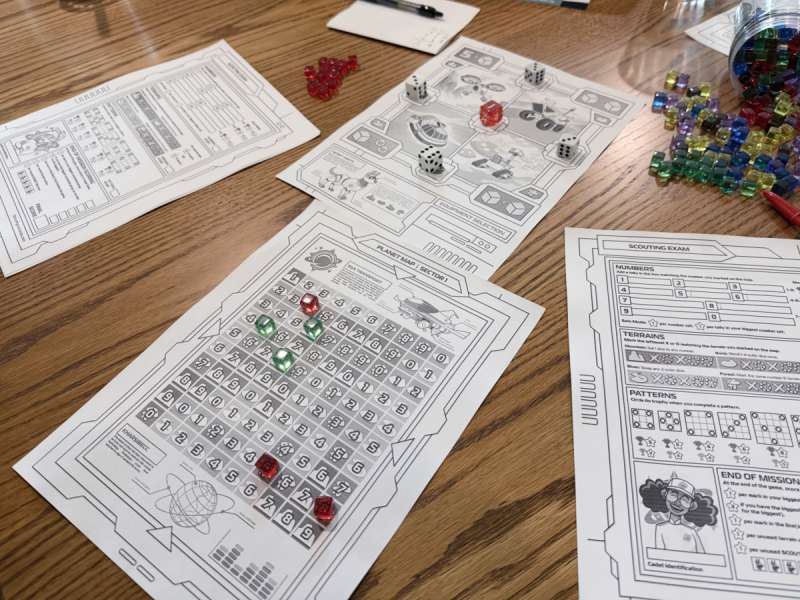
My wife and I tried a game where we used the house rule that “every player shares the same dice, and they are re-rolled every turn.” This significantly sped up the game, which made it more fun for us. I encourage you experiment with various house rules to see what you enjoy most.
Shiny Pigeon Games has included a set of alternate rules and a separate play through video for solo mode.
What I like about Starfront Scouting Academy game
- Space exploration and final exams!
- A roll-and-write game that is also a print-and-play
- A communal sheet (the planet map) for controlling limited resources
What needs to be improved?
- Make the rules more clear
- Find a way to pick up the pace of the game
- Eliminate making a straight line to the end game condition as a viable option for winning
Price: $5 to $100
Where to buy: Kickstarter
Source: The sample of this product was provided for free by Shiny Pigeon Games. They did not have a final say on the review and did not preview the review before it was published.


